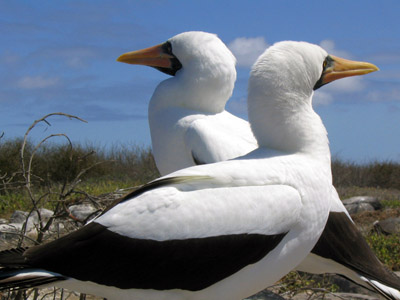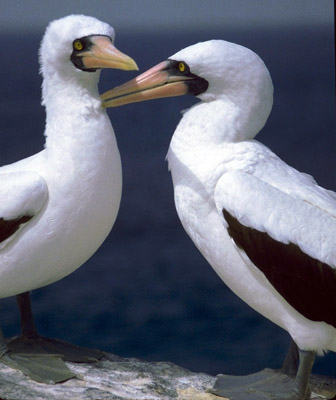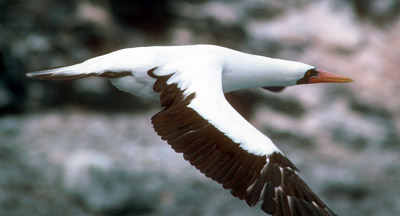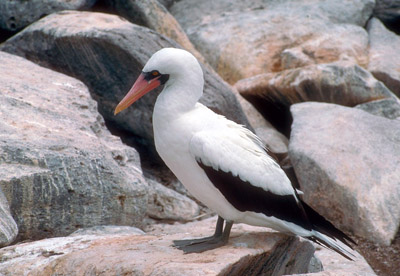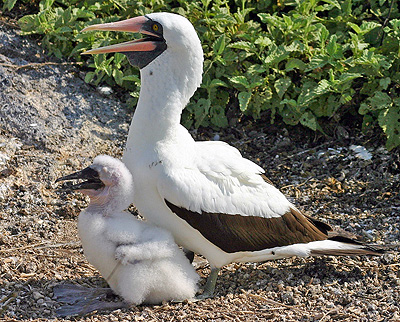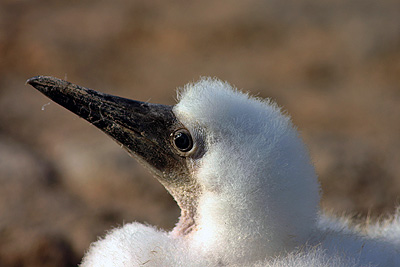Possibly the most elegant of the boobies on the Galapagos, adult Nazca Boobies are almost entirely white with black tail feathers and and black tips to the primary flight feathers. The yellow bill is brighter in the males and paler in the females.
A typical soaring bird profile with a large aspect ratio - wings that are very long compared to their width. Sea birds use the winds to fly more than they use their muscles which are mainly for getting airborne.
Nazca Booby - Sula granti
Profile - Animals of the Galapagos
One of three species of boobies found on the Galapagos Islands, the Nazca Booby is very similar to the Maskked Booby (found elsewhere) but has been shown to be a separate species. The bill colour varies somewhat in colour between the populations on different islands.
Nazca / masked booby facts - Basics
Weight: 1.3 - 2.3 kg (3.3 - 5 lb) females are slightly larger than males.
Length : 76 - 89 cm (30 - 35 in) Wingspan: up to 1.8m (6ft)
Breeding: An opportunistic breeder in common with many tropical birds, breeding can happen at any time of the year often prompted by plentiful food. After courtship which is less elaborate than the other Galapagos boobies, 2 eggs are usually laid 4 to 9 days apart in a system known as asynchronous hatching, though only one chick is ever reared. There is no nest, the eggs are laid on bare ground on cliffs and steep slopes in colonies. Egg incubation takes 40 days, fledging happens after about 115 - 120 days and sexual maturity is reached in 3-4 years.
Feeding: Fish are the main food, usually caught while fishing in a flock of hundreds of birds by plunge diving, the birds fold their wings back and plunge from 10-30m (33-100ft). Nazca boobies feed further offshore than the other booby species and being larger birds tend to take larger prey, mainly sardines and flying fish.
Conservation status: Least concern, they are still locally abundant.
Distribution: Throughout the Galapagos Islands and no-where else (related and very similar masked boobies are found elsewhere in the Eastern tropical and sub tropical Pacific).
Predators: No predators on the adults, though some may become entangled in fishing gear from boats. Like any birds the eggs and young chicks may be vulnerable to native and introduced predators.
What are Nazca Boobies Like?
This is the largest of the three booby species found in the Galapagos, it is sometimes referred to as the "Masked Booby" Sula dactylatra, but this has been shown to be a separate species only fairly recently. The Galapagos species is Sula granti - the Nazca Booby.
The Nazca booby feeds in a very similar way to the other two species (blue-footed and red-footed), though they are segregated in their fishing grounds. Only the Blue Footed is regularly seen fishing as it does so inshore, the Nazca Booby, fishes further offshore and the Red Footed fishes the furthest out of all of them.
Nazca boobies exhibit an unusual behaviour called obligate siblicide (obligate - obliged, siblicide - the killing of a sibling). This occurs when the first born chick having become bigger and stronger than its nest mate "kills" the smaller chick by ejecting it from the nest. The larger chick doesn't directly kill its sibling, but once out of the nest it is ignored by the parents even though it may still be quite close. The result is that the ejected chick dies quite quickly from a fall in body temperature, predation or starvation. This is different to the facultative siblicide (facultative - occurring optionally in response to circumstances rather than by nature) shown by the blue footed booby whereby the larger sibling may similarly kill and even eat the younger chick in times of food scarcity, the Nazca booby siblicide is "persistent and unconditional" and occurs regardless of food supply.
There is an apparent waste of energy and resources in this system as the second chick is always killed, so why don't the birds just lay a single egg? It is thought that it persists as the second egg provides an insurance system against the loss of the first egg or chick, by the time the first chick is strong enough to eject its sibling, it will be strong enough to stand a much greater chance of surviving to fledge. Studies where Nazca boobies have been obliged to rear two chicks have shown that they are less likely to survive than when a single chick is reared. reference
pictures courtesy Charles J Sharp, used under CC2 Attribution Share alike Unported license
Top banner credit - Peter Wilton, used under CC2 Attribution Generic license.

